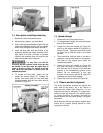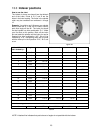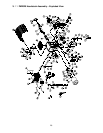
21
having it in the finished piece. Most checks radiate
from the pith.
As you turn bowls from green wood, make sure
you maintain a consistent wall thickness
throughout the piece. Leaving a piece thick in
some areas and thin in others will cause the wood
to dry unevenly and promote checks and cracks.
11.4.5 Distortion
Distortion is a problem associated with turning
green wood. It will vary from one type of wood to
the next. Typically, fruitwoods tend to distort more
than others. It also varies with the time of year the
tree was cut and how the logs are stored.
11.4.6 Tools for bowl turning
The deep fluted bowl gouge is the most essential
and versatile tool for most bowl and plate turning.
The bowl gouge is heavier and easier to control
than other types of gouges. It also allows removal
of wood much faster and with less vibration than
other gouges. Most average sized bowl work can
be accomplished with a 3/8" or 1/2" bowl gouge. A
1/4" bowl gouge is best suited for smaller bowls
and light finishing cuts. Larger 3/4" and 1" bowl
gouges are only used for extremely large pieces.
Large domed scrapers can also be used to help
clean up the interior surfaces of bowls. A light
touch with the scraper slightly tilted will eliminate
some of the ridges occasionally left by an
inexperienced bowl gouge.
11.4.7 Bowl Turning Techniques
To Shape Outside of Bowl:
1. Odd shaped burls, crotches and other irregular
shaped blanks require special preparation
before mounting in a chuck or onto a
faceplate. Remove the bark, if there is any,
from what appears to be the center of the top
of the workpiece.
2. Drive spur center into the top of the workpiece
with a mallet or dead blow hammer.
3. Slip the spur center into the headstock taper
and bring the tailstock with a live or ball
bearing center into position. Lock the tailstock
to the bed and advance the tailstock spindle in
order to seat the cup center into the
workpiece. Tighten the ram locking handle.
4. Turn workpiece by hand to ensure proper
clearance.
5. Start lathe at lowest speed and bring it up to
the maximum safe speed for the size of work
to be turned (see sect. 15.0). If the machine
starts to vibrate, lower the speed until vibration
stops.
6. Rough out the outside of the bowl with the 1/2"
deep fluted bowl gouge, holding the handle of
the tool firmly against your hip. For best
control, use your whole body to move the
gouge through the workpiece.
7. As the bowl takes shape, work on the bottom
(tailstock end) to accomodate attaching a face
plate.
8. Turn a short tenon (about 1/8" long) the size of
the hole in the faceplate. See Figure 34. This
will allow centering the workpiece when the
faceplate is attached.
Figure 34
9. (NOTE: If you plan to use a chuck, turn a
tenon of the appropriate length and diameter
to fit your chuck.)
10. Stop the lathe, remove workpiece and attach
face plate or chuck (see sect. 11.4.1, Mounting
Stock).
The surfaces of faceplate and
workpiece should mount flush to each other.
11. Finish turning the outside of bowl with 1/2" or
3/8" bowl gouge. Leave additional material at
base of bowl for support while turning interior.
This will be removed later.
To Shape Interior of Bowl:
1. Stop the lathe and move tailstock away. (You
may want to remove the center from the
tailstock to avoid bumping it with your elbow.)
2. Adjust tool support in front of the bowl just
below centerline, at a right angle to the lathe
ways.
3. Rotate workpiece by hand to check clearance.
4. Face off top of bowl by making a light shearing
cut across the top of workpiece, from rim to
center.
5. Place 1/2" bowl gouge on tool support at
center of the workpiece with the flute facing
top of bowl. The tool handle should be level
and pointed toward the four o'clock position, as
shown in Figure 35.


















